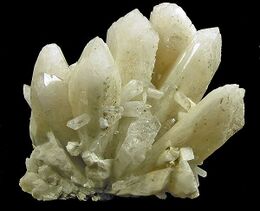Chemistry:Danburite
| Danburite | |
|---|---|
 Cluster of creamy crystals of danburite | |
| General | |
| Category | Tectosilicates |
| Formula (repeating unit) | CaB2(SiO4)2 |
| Strunz classification | 9.FA.65 |
| Dana classification | 56.3.1.1 |
| Crystal system | Orthorhombic |
| Crystal class | Dipyramidal (mmm) H-M symbol: (2/m 2/m 2/m) |
| Space group | Pnam |
| Unit cell | a = 8.038(3), b = 8.752(5) c = 7.73 [Å]; Z = 4 |
| Identification | |
| Colour | Colourless, white, gray, brownish white, straw yellow |
| Crystal habit | Euhedral prismatic crystals; disseminated masses |
| Cleavage | {001} Poor |
| Fracture | Subconchoidal to uneven |
| Tenacity | Brittle |
| Mohs scale hardness | 7 – 7.5 |
| Vitreous to greasy|re|er}} | Vitreous to greasy |
| Streak | White |
| Diaphaneity | Transparent to translucent |
| Specific gravity | 2.93 – 3.02 |
| Optical properties | Biaxial (+/-) |
| Refractive index | nα = 1.627 – 1.633 nβ = 1.630 – 1.636 nγ = 1.633 – 1.639 |
| Birefringence | δ = 0.006 |
| 2V angle | 88 to 90° measured |
| Dispersion | r < v strong |
| Ultraviolet fluorescence | Fluorescent and thermoluminescent (red); Short UV=violet blue; Long UV=blue to blue-green |
| References | [1][2][3] |
Danburite is a calcium boron silicate mineral with a chemical formula of CaB2(SiO4)2.[5]
It has a Mohs hardness of 7 to 7.5 and a specific gravity of 3.0.[5] The mineral has an orthorhombic crystal form.[5] It is usually colourless, like quartz, but can also be either pale yellow[5] or yellowish-brown. It typically occurs in contact metamorphic rocks.
The Dana classification of minerals categorizes danburite as a sorosilicate, while the Strunz classification scheme lists it as a tectosilicate;[3] its structure can be interpreted as either.
Its crystal symmetry and form are similar to topaz; however, topaz is a calcium fluorine bearing nesosilicate. The clarity, resilience, and strong dispersion of danburite make it valuable as cut stones for jewelry.
It is named for Danbury, Connecticut, United States , where it was first discovered in 1839 by Charles Upham Shephard.[5]

References
- ↑ Danburite data on Webmineral
- ↑ "Danburite in The Handbook of Mineralogy". http://www.handbookofmineralogy.com/pdfs/danburite.pdf.
- ↑ 3.0 3.1 Danburite on Mindat.org
- ↑ Warr, L.N. (2021). "IMA–CNMNC approved mineral symbols". Mineralogical Magazine 85 (3): 291–320. doi:10.1180/mgm.2021.43. Bibcode: 2021MinM...85..291W.
- ↑ 5.0 5.1 5.2 5.3 5.4 Chisholm, Hugh, ed (1911). "Danburite". Encyclopædia Britannica. 7 (11th ed.). Cambridge University Press. p. 793.
 |

